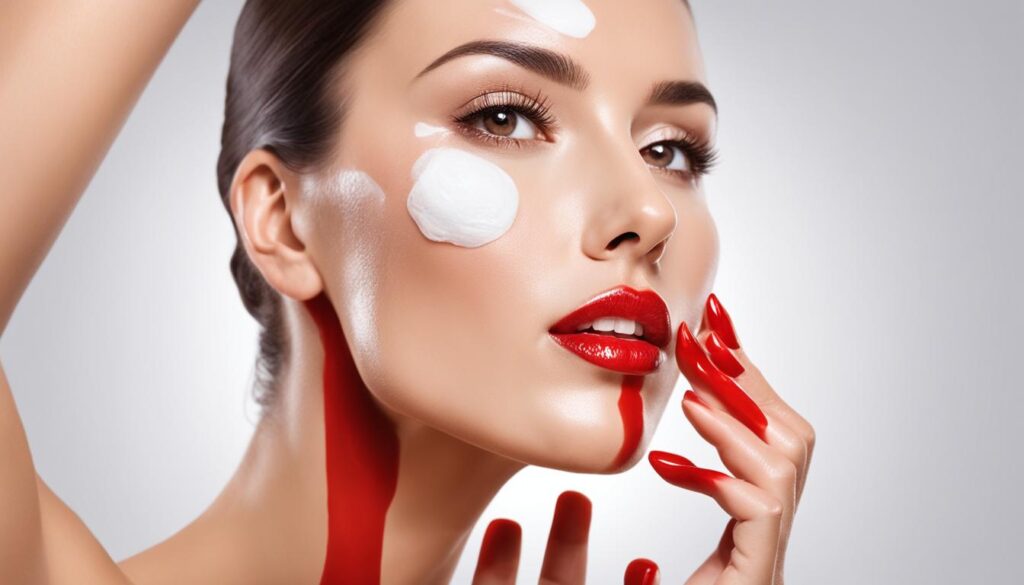Welcome to my in-depth guide on the uses and benefits of Alpha Hydroxy Acids (AHAs) in skincare. AHAs are plant and animal-derived acids commonly found in skincare products. They offer a range of benefits, including exfoliating the skin, brightening the complexion, reducing the appearance of fine lines and wrinkles, and treating acne.
To start with, let’s explore how AHAs work. AHAs primarily exfoliate the skin by removing dead skin cells and promoting the generation of new ones. This process leads to a smoother and more radiant complexion. The most well-researched AHAs are glycolic and lactic acids, which are known for their effectiveness and minimal irritation.
But that’s not all. AHAs also promote collagen production, which helps maintain the skin’s plumpness and smoothness. They can also minimize and correct discoloration, increase blood flow to the skin, and enhance the absorption of other skincare products.
Now that you understand the broad benefits of AHAs, let’s dive deeper into each specific use and their associated benefits. Whether you’re looking to exfoliate, brighten your skin, reduce the signs of aging, treat acne, or improve product absorption, AHAs can be a valuable addition to your skincare routine.
Key Takeaways:
- Alpha Hydroxy Acids (AHAs) offer various benefits for the skin, including exfoliation, brightening, anti-aging effects, acne treatment, and enhanced product absorption.
- Glycolic and lactic acids are the most well-researched AHAs and are less likely to cause irritation.
- AHAs promote collagen production, minimize discoloration, increase blood flow to the skin, and improve the overall appearance of the complexion.
- It is important to choose high-quality AHAs, follow usage tips and cautions, and be aware of potential side effects, such as temporary irritation and sun sensitivity.
- AHAs can be used in combination with other skincare products to maximize their benefits.
Exfoliation

Alpha Hydroxy Acids (AHAs) are highly effective in exfoliating the skin, helping you achieve a smoother and more radiant complexion. By removing dead skin cells and promoting the regeneration of new ones, AHAs reveal a fresher and healthier skin surface. Let’s explore how to use Alpha Hydroxy Acids properly for exfoliation, the best quality selection, and storage tips.
How to Use Alpha Hydroxy Acids for Exfoliation
To incorporate AHAs into your skincare routine effectively, start with products containing lower AHA concentrations, such as facial cleansers or toners. This allows your skin to gradually adjust to the exfoliating properties of AHAs. Once your skin has acclimated, you can consider using products with higher concentrations for more intense exfoliation, like glycolic acid peels.
“Starting with lower concentrations of AHAs allows your skin to properly adjust to their exfoliating effects.”
Best Quality Selection for Exfoliation
When selecting AHA products for exfoliation, opt for trusted and reputable skincare brands known for their high-quality formulations. Look for products that clearly state the concentration of AHAs on the label. Starting with products that contain a lower percentage of AHAs, such as 5-8%, is generally recommended for gentle and regular exfoliation.
Storage Tips
To maintain the efficacy of your AHA products, it is crucial to store them properly. Choose a cool and dry place away from direct sunlight, as heat and light can degrade the active ingredients in AHAs. Consider transferring your AHA products to opaque or dark-colored containers to further protect them from light exposure.
| AHA Product | Recommended Concentration | Storage Tips |
|---|---|---|
| AHA Facial Cleanser | 5-8% | Store in a cool, dry place |
| AHA Toner | 5-10% | Avoid direct sunlight |
| Glycolic Acid Peel | 10-20% | Transfer to opaque containers |
By following these guidelines for using AHAs for exfoliation, selecting quality products, and storing them correctly, you can maximize the benefits of AHAs in achieving a vibrant and rejuvenated complexion.
Brightening the Skin
When it comes to achieving a brighter and more radiant complexion, Alpha Hydroxy Acids (AHAs) are an excellent choice in skincare. These powerful acids work by exfoliating the skin, effectively removing dead skin cells and revealing a more luminous appearance. Specifically, AHAs such as glycolic acid and citric acid are known for their exceptional brightening properties.
One effective way to incorporate AHAs into your skincare routine is through the use of daily products like moisturizers that contain these acids. By using such products consistently, you can experience the benefits of AHAs for brightening the skin on a daily basis. Remember, when shopping for AHA skincare products, always prioritize high-quality options to ensure you’re getting the best results.
As you integrate AHAs into your skincare regimen, it’s important to keep in mind a few usage tips and cautions. First, start with lower concentrations of AHAs and gradually increase as your skin becomes accustomed to the acids. This approach helps minimize the risk of potential side effects and allows your skin to adjust gradually. Additionally, always follow the instructions provided with the product and be mindful of any specific warnings or precautions.
Using AHAs, such as glycolic acid and citric acid, can significantly brighten the complexion by exfoliating the skin and revealing a more luminous appearance. To achieve consistent brightening effects, incorporate daily products like moisturizers containing AHAs into your skincare routine. However, remember to choose high-quality options and follow usage tips and cautions to ensure optimal results.
| Benefits of using Alpha Hydroxy Acids for brightening the skin: |
|---|
| 1. Exfoliating Power: AHAs remove dead skin cells, revealing a brighter complexion. |
| 2. Luminosity Boost: Glycolic acid and citric acid are particularly effective in brightening the skin. |
| 3. Daily Use: Moisturizers with AHAs provide consistent brightening effects with regular use. |
Promoting Collagen Production

Collagen is a vital protein that contributes to the plumpness and smoothness of our skin. Unfortunately, as we age, our collagen production naturally declines, leading to sagging skin and the formation of wrinkles. Thankfully, incorporating Alpha Hydroxy Acids (AHAs) into our skincare routine can help combat these signs of aging by stimulating the production of new collagen.
AHAs work their magic by removing old collagen fibers, effectively pushing our skin to generate fresh collagen. This process helps to restore plumpness, resulting in a more youthful appearance. Choosing high-quality AHAs is crucial when aiming to maximize the anti-aging benefits they offer.
| Benefits of AHAs in Promoting Collagen Production | Best Quality Selection |
|---|---|
|
|
By incorporating AHAs into your skincare routine, you can naturally boost collagen production and restore the youthful appearance of your skin.
Reducing the Appearance of Surface Lines and Wrinkles
Alpha Hydroxy Acids (AHAs) are widely recognized for their anti-aging benefits, including their ability to diminish the appearance of surface lines and wrinkles. A study conducted on AHAs revealed that after a three-week period, 90% of participants experienced an improvement in overall skin texture. This finding highlights the effectiveness of AHAs in reducing the signs of aging.
It is important to note that AHAs specifically target surface lines and wrinkles, and deeper wrinkles may require alternative treatments. To achieve the desired results, it is crucial to select high-quality AHAs and follow the recommended usage tips and cautions.
Usage Tips:
- Start with a lower concentration of AHAs for daily use and gradually increase as tolerated.
- Consistency is key—incorporate AHAs into your skincare routine regularly for best results.
- Apply AHAs in the evening, as they can increase sun sensitivity.
- Always follow up with a broad-spectrum sunscreen during the day to protect your skin.
Cautions:
- Avoid using AHAs with concentrations higher than 10% as recommended by the FDA, as they may cause potential side effects.
- Temporary irritation, burning, itching, blisters, and dermatitis are possible side effects—discontinue use if any adverse reactions occur.
- Keep AHAs away from the eye area to prevent irritation.
By incorporating AHAs into your skincare routine and following proper usage tips and cautions, you can effectively reduce the appearance of surface lines and wrinkles, promoting a more youthful and rejuvenated complexion.
Promoting Blood Flow to the Skin

AHAs, such as Glycolic Acid and Lactic Acid, have gained popularity in skincare for their ability to promote blood flow to the skin. This increased blood circulation brings vital nutrients and oxygen to the skin cells, resulting in a healthier and more vibrant complexion.
Proper blood flow is crucial for the optimal function of skin cells. When the skin receives sufficient nutrients, it can repair itself more efficiently and maintain its youthful appearance. By incorporating AHAs into your skincare routine, you can enhance blood flow and improve the overall health and appearance of your skin.
The Benefits of Promoting Blood Flow to the Skin
Enhancing blood flow to the skin offers several benefits:
- Healthy complexion: Improved blood circulation gives your skin a natural, healthy glow.
- Increased cell turnover: When skin cells receive sufficient nutrients, they can regenerate at a faster rate, resulting in smoother, more youthful-looking skin.
- Improved product absorption: With enhanced blood flow, your skin becomes more receptive to the active ingredients in your skincare products, allowing them to penetrate deeper and work more effectively.
However, it’s important to note that not all AHAs are created equal. When selecting products, choose high-quality options that contain the right concentration of AHAs to achieve the desired results. Additionally, follow proper usage tips and cautions to ensure maximum benefits without adverse effects.
Pro Tip: Want to experience the benefits of enhanced blood flow to your skin? Try incorporating a high-quality AHA serum or moisturizer into your skincare routine. Remember to patch test new products and gradually introduce them to your routine to avoid any potential irritation.
| Usage Tips | Cautions |
|---|---|
|
|
Minimizing and Correcting Discoloration

AHAs play a crucial role in reducing and correcting various skin discolorations, including age spots, melasma, and post-inflammatory hyperpigmentation. These conditions can often be a source of frustration and self-consciousness for individuals seeking to achieve an even, radiant complexion. Thankfully, Alpha Hydroxy Acids offer a solution that can effectively address these concerns.
The secret behind AHAs’ ability to minimize and correct discoloration lies in their remarkable capacity to promote skin cell turnover. By accelerating the exfoliation process, AHAs help eliminate the buildup of old, discolored skin cells and reveal the fresh, evenly pigmented skin beneath. Among the diverse selection of AHAs available, glycolic acid has garnered particular acclaim for its effectiveness in treating discoloration.
However, it’s crucial to exercise caution when incorporating AHAs into your skincare routine. Choose products that feature high-quality Alpha Hydroxy Acids to ensure safe and effective treatment of discoloration. Additionally, it’s essential to follow usage tips and cautions provided by skincare professionals to fully capitalize on the benefits of these powerful ingredients.
| Benefits of using Alpha Hydroxy Acids for discoloration: |
|---|
| Promotes skin cell turnover: AHAs facilitate the removal of discolored skin cells, revealing fresh and evenly pigmented skin. |
| Effective in treating diverse discolorations: AHAs can address age spots, melasma, and post-inflammatory hyperpigmentation. |
| Glycolic acid for discoloration: Glycolic acid is highly recommended for its efficacy in diminishing discoloration. |
| Choose high-quality products: Opt for reputable brands that offer reliable and top-notch Alpha Hydroxy Acid formulations. |
| Follow usage tips and cautions: Adhere to professional recommendations to ensure safe and effective treatment of discoloration. |
By leveraging the powerful properties of Alpha Hydroxy Acids, individuals can effectively minimize and correct discoloration, achieving a more even, radiant complexion. Incorporating high-quality AHAs into your skincare routine, along with following proper usage tips and cautions, can help you attain the desired results in a safe and effective manner.
Treating and Preventing Acne

Alpha Hydroxy Acids (AHAs) can be highly effective in treating and preventing acne. Their exfoliating properties work to remove dead skin cells and prevent the build-up of oil that can clog pores, leading to acne breakouts. AHAs also have the ability to reduce the size of enlarged pores and address acne scars, promoting clearer and smoother skin.
While glycolic and lactic acids are commonly used AHAs for acne treatment, citric and malic acids are additional options that can help soothe inflamed skin and reduce redness associated with acne. It is important to choose high-quality AHAs specifically formulated for acne-prone skin to ensure maximum efficacy.
When incorporating AHAs into your skincare routine for acne treatment, there are a few usage tips and cautions to keep in mind:
- Start with lower concentrations of AHAs and gradually increase as tolerated to avoid potential irritation.
- Apply AHAs as directed, usually in the evening after cleansing the skin.
- Follow up with a moisturizer to prevent dryness, as AHAs can sometimes have a drying effect.
- Use AHAs consistently to see the best results. Results may vary, but improvements in acne can typically be seen after several weeks of regular use.
It is important to note that AHAs may not be suitable for everyone, particularly if you have extremely sensitive or irritated skin. If you experience any adverse reactions, such as increased redness or irritation, discontinue use and consult a dermatologist.
| Benefit | Description |
|---|---|
| Exfoliates the skin | Removes dead skin cells and prevents the buildup of oil and debris that can lead to acne |
| Reduces pore size | Helps minimize the appearance of enlarged pores, resulting in smoother and more refined skin |
| Addresses acne scars | Can help fade acne scars and improve overall skin texture and tone |
| Soothes inflamed skin | Citric and malic acids have anti-inflammatory properties that can calm and soothe irritated skin |
When used correctly and with appropriate caution, AHAs can be a valuable addition to your skincare routine for acne treatment. However, it is always advisable to consult a dermatologist for personalized recommendations that take into account your specific skin concerns and conditions.
Increasing Product Absorption

Alpha Hydroxy Acids (AHAs) not only offer their own benefits, but they also enhance the absorption of other skincare products. By exfoliating the skin and removing dead skin cells, AHAs create a smoother surface for better penetration of active ingredients found in serums, moisturizers, and other skincare products. This means that when you incorporate AHAs into your routine, you’re not only reaping the benefits of their exfoliating properties but also maximizing the efficacy of the products you apply afterwards.
Using high-quality AHAs is essential to ensure optimal results. Look for reputable brands that source their AHAs from natural plant and animal-derived sources. These products undergo rigorous testing and quality control measures to ensure their potency and safety.
“By exfoliating the skin and removing dead skin cells, AHAs allow for better penetration of active ingredients in serums, moisturizers, and other products.”
Here are some usage tips and cautions to keep in mind when incorporating AHAs into your skincare routine:
- Start with a lower concentration of AHAs and gradually increase as tolerated. This allows your skin to adjust and minimizes the risk of irritation.
- Use AHAs at night, as they can increase sensitivity to sunlight. If you prefer to use them during the day, make sure to apply a broad-spectrum sunscreen with SPF of 30 or higher to protect your skin.
- Consult with a dermatologist if you have sensitive skin or any underlying skin conditions to ensure safe and effective use of AHAs.
By following these tips and using AHAs responsibly, you can enjoy the benefits of increased product absorption and take your skincare routine to the next level.
Recommended AHA Concentration and Side Effects

When incorporating Alpha Hydroxy Acids (AHAs) into your skincare routine, it is important to consider the recommended AHA concentration and be aware of possible side effects. The FDA advises using AHAs with concentrations of less than 10 percent to prevent potential side effects. Products with concentrations higher than 15 percent should be avoided, as they can increase the risk of adverse reactions.
When starting to use AHAs, it is best to begin with lower concentrations for daily use and gradually increase as tolerated. This allows your skin to acclimate to the exfoliating properties of AHAs and reduces the risk of irritation or sensitivity.
| Recommended Steps | Usage Tips | Cautions |
|---|---|---|
| Start with lower AHA concentrations for daily use | Follow the product instructions for application | Avoid using AHAs on broken or irritated skin |
| Gradually increase AHA concentration as tolerated | Use AHAs every other day initially and gradually increase to daily use | Perform a patch test on a small area of skin before using on the entire face |
| Wear sunscreen daily | Avoid using AHAs in combination with other exfoliating products | Discontinue use if any severe side effects occur |
While AHAs are generally safe to use, there are some potential side effects to be aware of. Common side effects include temporary irritation, burning, itching, blisters, and dermatitis. These side effects are usually mild and subside over time as your skin adjusts to the AHAs.
It is important to note that AHAs can increase sun sensitivity, so it is crucial to wear sunscreen daily and limit sun exposure while using these products. Protecting your skin from harmful UV rays will help prevent further damage and ensure the best results from your skincare routine.
Difference Between AHA and BHA
When it comes to skincare, understanding the difference between Alpha Hydroxy Acids (AHAs) and Beta Hydroxy Acids (BHAs) is essential. While both are organic acids commonly used in skincare, they have distinct properties and benefits for specific skin concerns.
AHAs, such as glycolic and lactic acids, are more suitable for age-related skin concerns, such as fine lines, wrinkles, and dullness. They are known for their exfoliating properties, helping to remove dead skin cells and promote cellular turnover, resulting in a smoother and brighter complexion. Additionally, AHAs can promote collagen production, reduce discoloration, and improve the absorption of other skincare products. AHAs are particularly effective for anti-aging and overall skin rejuvenation.
BHAs, on the other hand, are often preferred for oily and acne-prone skin. Salicylic acid is the most common BHA used in skincare products. BHAs also have exfoliating properties but with the added benefit of being oil-soluble. This allows BHAs to penetrate deeper into the pores, effectively unclogging them and reducing oiliness. BHAs are known for their ability to treat and prevent acne breakouts, minimize pore size, and address blackheads and whiteheads.
“AHAs are ideal for addressing age-related concerns, while BHAs are excellent for managing oily and acne-prone skin.” – Dr. Jessica Thompson
It’s important to note that both AHAs and BHAs can benefit the skin when used correctly and in appropriate concentrations. Incorporating either or both into your skincare routine will depend on your specific skin type and concerns. It’s always advisable to consult with a dermatologist or skincare professional to determine the best approach for your individual needs.
| Alpha Hydroxy Acids (AHAs) | Beta Hydroxy Acids (BHAs) |
|---|---|
| Benefits include: exfoliation, anti-aging effects, discoloration correction, increased product absorption | Benefits include: exfoliation, oil control, acne treatment, reduced pore size |
| Glycolic acid, lactic acid, citric acid | Salicylic acid |
| Effective for age-related concerns | Effective for oily and acne-prone skin |
Understanding the differences between AHAs and BHAs allows you to make informed choices when selecting skincare products and tailoring your routine to address your specific skin concerns. Both can be powerful tools in achieving and maintaining healthy, radiant skin.
Conclusion
Alpha Hydroxy Acids (AHAs) offer a multitude of benefits for your skin, making them a valuable addition to your skincare routine. These powerful acids provide exfoliation, brightening, anti-aging effects, discoloration correction, acne treatment, and improved product absorption. By incorporating AHAs into your daily skincare regimen, you can achieve a radiant and youthful complexion.
However, it is crucial to choose high-quality AHAs and follow usage tips and cautions to ensure optimal results. When selecting AHAs, look for reputable brands that offer reliable and effective formulations. It is also important to follow the recommended concentrations and gradually increase usage as tolerated.
While AHAs offer fantastic benefits, it’s crucial to be aware of potential side effects. Temporary irritation, burning, itching, blisters, or dermatitis may occur, especially if you have sensitive skin. It’s important to use AHAs every other day initially and gradually increase to daily use, paying attention to any adverse reactions. Additionally, AHAs can increase sun sensitivity, so always wear sunscreen and avoid prolonged sun exposure.
Incorporating Alpha Hydroxy Acids into your skincare routine can make a remarkable difference in the health and appearance of your skin. By choosing the right products, using them correctly, and being mindful of potential side effects, you can harness the full benefits of AHAs and achieve the glowing, youthful complexion you desire.
FAQ
What are the uses and benefits of Alpha Hydroxy Acids (AHAs)?
Alpha Hydroxy Acids have various uses in skincare, including exfoliation, brightening the complexion, reducing the appearance of fine lines, promoting collagen production, minimizing discoloration, treating acne, and increasing product absorption.
How do AHAs promote exfoliation?
AHAs exfoliate the skin by removing dead skin cells and promoting the generation of new ones. This leads to a brighter and more radiant complexion. The type and concentration of the AHA used in the product determine the intensity of exfoliation.
How can I use AHAs for exfoliation and what storage precautions should I take?
It is recommended to start with lower AHA concentrations for daily use and gradually increase as tolerated. For more intense exfoliation, products with higher AHA concentrations can be used. AHAs should be stored in a cool and dry place to maintain their efficacy.
How do AHAs brighten the skin?
AHAs, such as glycolic acid and citric acid, are effective in brightening the skin by removing dead skin cells and revealing a more radiant complexion. Daily use products, such as moisturizers containing AHAs, can provide consistent brightening effects.
What should I consider when using AHAs for brightening the skin?
To achieve optimal results and avoid potential side effects, it is important to choose high-quality products and follow usage tips and cautions provided by the manufacturers.
How do AHAs promote collagen production?
AHAs promote collagen production by removing old collagen fibers and stimulating the growth of new ones. This can result in plumper and more youthful-looking skin.
How do AHAs reduce the appearance of surface lines and wrinkles?
AHAs are effective in reducing the appearance of surface lines and wrinkles by improving overall skin texture. However, deeper wrinkles may require other treatments.
How do AHAs promote blood flow to the skin?
AHAs have anti-inflammatory properties that can help promote blood flow to the skin, resulting in a healthier and more vibrant complexion. Proper blood flow ensures that skin cells receive the necessary nutrients for optimal function.
How do AHAs minimize and correct skin discoloration?
AHAs promote the turnover of skin cells, helping to eliminate old, discolored cells and reveal evenly pigmented new skin cells. Glycolic acid is particularly recommended for discoloration treatment.
How do AHAs treat and prevent acne?
AHAs exfoliate the skin and prevent the buildup of dead skin cells and oil that can clog pores, leading to acne breakouts. AHAs can also reduce the size of enlarged pores and address acne scars.
How do AHAs enhance product absorption?
By exfoliating the skin and removing dead skin cells, AHAs allow for better penetration of active ingredients in other skincare products, such as serums and moisturizers.
What is the recommended concentration of AHAs and what are the possible side effects?
The FDA recommends using AHAs with concentrations of less than 10 percent to prevent potential side effects. Products with concentrations higher than 15 percent should be avoided. Possible side effects include temporary irritation, burning, itching, blisters, and dermatitis. It is important to use AHAs according to the provided usage tips and cautions and wear sunscreen to avoid sun sensitivity.
What is the difference between AHA and BHA?
AHAs are suitable for age-related skin concerns, such as fine lines and wrinkles, while BHAs are often preferred for oily and acne-prone skin. BHAs, such as salicylic acid, are effective in reducing oiliness, unclogging pores, and treating acne.






